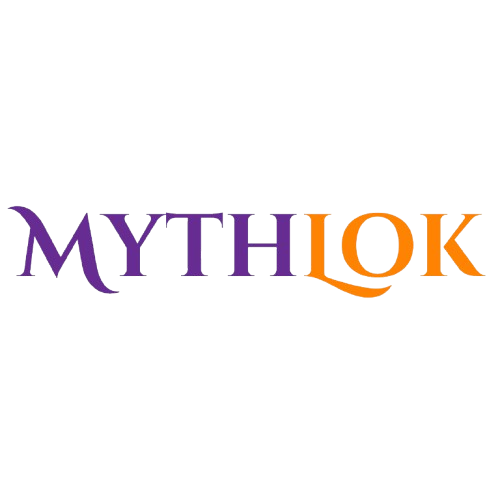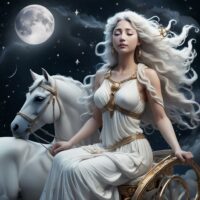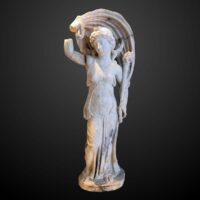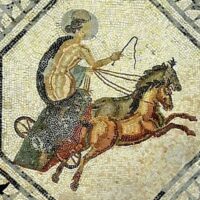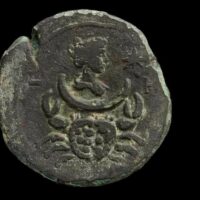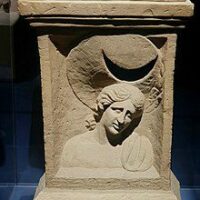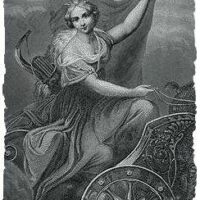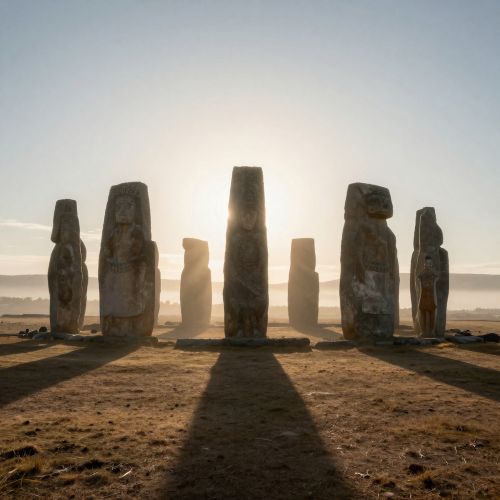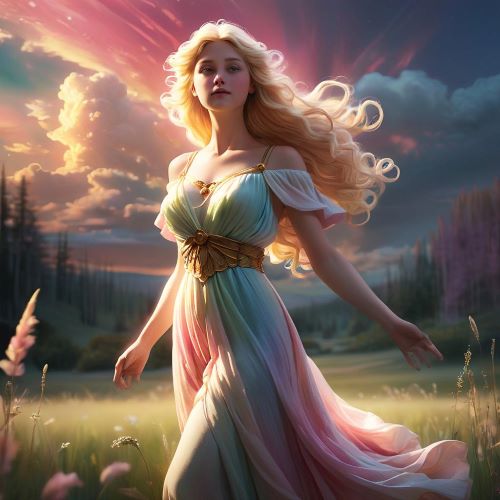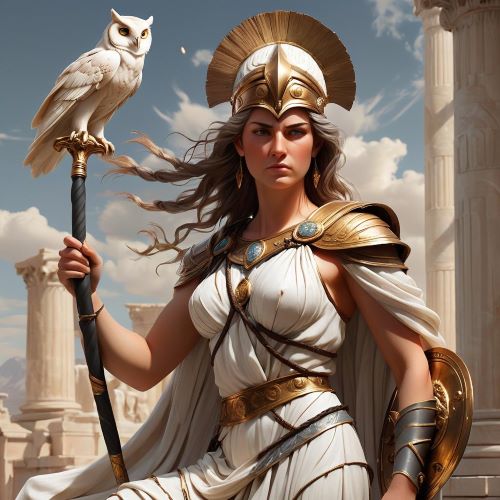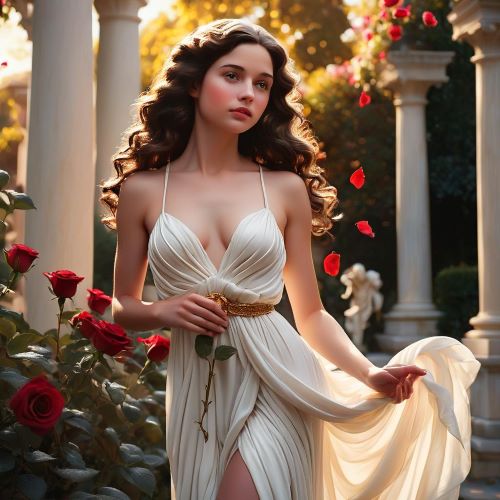Luna : The Moon Goddess
Listen
At a glance
| Description | |
|---|---|
| Origin | Roman Mythology |
| Classification | Gods |
| Family Members | Sol, Aurora (Sisters) |
| Region | Italy |
| Associated With | Moon, Lunar Cycles |
Luna
Introduction
In Roman mythology, Luna is the celestial embodiment of the moon, revered for her ethereal beauty and mysterious allure. She holds a significant position in the pantheon of Roman deities, often associated with other lunar goddesses like Diana and Hecate. Luna, also known as Lvna in Latin, represents the moon’s heavenly influence and governs the tides, the cycles of nature, and the hidden depths of the human psyche. She complements Sol, the sun god, highlighting the balance and harmony between day and night.
Luna is considered one of the primordial forces, reflecting the mystical nature of the moon in the sky. Her name directly translates to “moon” in Latin, underscoring her essential role in Roman religious life. Often compared to her Greek counterpart, Selene, Luna is depicted as a radiant figure, illuminating the night sky and guiding both gods and mortals with her celestial light.
As a central figure in Roman mythology, Luna played a significant role in various religious rituals and festivals, reflecting the moon’s importance in agriculture and daily life. The moon, governed by Luna, was seen as a source of cyclical time, influencing tides, agricultural cycles, and human emotions. Her presence was celebrated in numerous festivals, where offerings and prayers were made to seek her blessings for fertility, protection, and guidance.
Physical Traits
Luna is often portrayed as a resplendent woman of ethereal beauty, characterized by her serene and calming presence. Her most distinctive feature is the crescent moon adorning her forehead, symbolizing her dominion over the night sky and her lunar authority. Her skin is as pale as moonlight, and her eyes reflect the depths of the night sky, embodying the mysterious qualities of the moon.
In artistic representations, Luna is typically shown with long, flowing hair, symbolizing the moon’s connection to the tides and the cyclical nature of time. She is often adorned in a shimmering gown that mirrors the moon’s glow, emphasizing her ethereal nature. Her chariot, pulled by two white horses, gracefully carries her across the heavens, casting a silvery light that illuminates the night. Her gentle and serene expression captures the moon’s calming influence on the world, embodying tranquility and wisdom. Luna’s radiant figure and attire reflect her role as the goddess of nocturnal magic, illuminating the world below with her soft, silvery light.
Family
Luna holds a primordial position within the Roman pantheon as a Titan. She is the daughter of Hyperion, the Titan god of heavenly light, and Theia, the goddess of sight. Her siblings include Sol, the sun god, and Aurora, the goddess of dawn. This familial connection highlights the interconnectedness of celestial bodies and the rhythmic passage of time, forming a celestial triad that represents the cosmic balance between day and night.
In Roman mythology, Luna’s divine lineage places her among several other prominent deities. She is often considered the sister of Sol, emphasizing the harmony between the sun and moon and their crucial roles in maintaining the natural order of the universe. Luna is sometimes associated with Diana, the Roman goddess of the hunt, representing the moon’s influence on nature and wildlife. This association underscores the interconnectedness of the Roman pantheon, where deities often share attributes and domains, reflecting the complexity and richness of Roman mythology.
Other names
Luna is widely recognized by her Roman name but is also linked with various lunar deities across different cultures. In Greek mythology, she is equated with Selene, the goddess of the moon, sharing many attributes, including her role as the divine embodiment of the moon and her connection to the celestial realm. This reflects the blending of Roman and Greek religious traditions, where deities often share similar characteristics.
In Roman traditions, Luna is sometimes associated with the goddess Trivia, who is connected to the phases of the moon and the concept of crossroads. This association underscores Luna’s multifaceted nature and her influence on various aspects of the moon’s impact on the world.
Aside from Luna, she is known by other titles reflecting her diverse aspects. Her Greek counterpart, Selene, is commonly associated with her, while Phoebe, meaning “bright one,” highlights her radiant qualities. Additionally, she is referred to as Diana Lucifera, emphasizing her role as a source of light. Roman adaptations of Greek myths, such as the tale of Endymion, are depicted in various Roman artworks, illustrating her enduring cultural significance.
Powers and Abilities
As the goddess of the moon, Luna wields a range of powers that reflect her celestial role. She illuminates the night sky with her soft, silvery light, guiding travelers and inspiring poets with her radiant presence. Luna’s influence extends to the tides, as the moon’s gravitational pull controls the ebb and flow of the oceans, symbolizing her connection to natural cycles and the rhythms of life.
Her role in marking time is also significant, with the lunar calendar playing a crucial part in Roman society. This connection to time made her an essential deity for agricultural communities, who relied on her guidance for planting and harvesting crops. Luna’s influence reaches into the nocturnal world, where she governs dreams, sleep, and the subconscious mind.
Additionally, Luna is associated with fertility and childbirth, reflecting the moon’s cyclical nature. Her powers extend to magic and divination, with her connection to the night and the hidden realms lending her an aura of mystery and wisdom. Oracles and seers often sought her guidance, believing she could reveal secrets and predict the future.
Modern Day Influence
Luna’s influence extends well beyond ancient mythology into modern culture. Her association with the moon has inspired a wide array of artistic and literary works, where she symbolizes mystery, femininity, and the cyclical nature of existence. The moon’s persistent presence in the night sky underscores Luna’s timeless impact, serving as a constant reminder of her celestial significance.
In contemporary spirituality and astrology, Luna represents intuition, emotion, and the subconscious. Her phases are often used to explore personal growth and self-discovery, with many people seeking guidance from the moon’s cycles to navigate modern life. This connection to Luna reflects a deep-rooted fascination with the moon’s role in shaping personal and spiritual journeys.
Luna’s legacy is also evident in the terminology associated with the moon, such as “lunar,” and in popular culture where she appears as a mystical and enchanting figure. Her name influences scientific exploration and space missions, illustrating her enduring impact on humanity’s understanding of the cosmos. The moon’s symbolism, linked to Luna, continues to evoke themes of romance, introspection, and wonder, inspiring both artistic expression and scientific curiosity.
Related Images
Frequently Asked Questions
What is lorem Ipsum?
I am text block. Click edit button to change this text. Lorem ipsum dolor sit amet, consectetur adipiscing elit. Ut elit tellus, luctus nec ullamcorper mattis, pulvinar dapibus leo.
What is lorem Ipsum?
I am text block. Click edit button to change this text. Lorem ipsum dolor sit amet, consectetur adipiscing elit. Ut elit tellus, luctus nec ullamcorper mattis, pulvinar dapibus leo.
What is lorem Ipsum?
I am text block. Click edit button to change this text. Lorem ipsum dolor sit amet, consectetur adipiscing elit. Ut elit tellus, luctus nec ullamcorper mattis, pulvinar dapibus leo.
What is lorem Ipsum?
I am text block. Click edit button to change this text. Lorem ipsum dolor sit amet, consectetur adipiscing elit. Ut elit tellus, luctus nec ullamcorper mattis, pulvinar dapibus leo.
What is lorem Ipsum?
I am text block. Click edit button to change this text. Lorem ipsum dolor sit amet, consectetur adipiscing elit. Ut elit tellus, luctus nec ullamcorper mattis, pulvinar dapibus leo.

